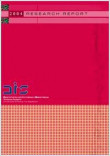
Dipartimento di Informatica e Sistemistica “Antonio Ruberti” della “Sapienza” Università di Roma
Technical Reports
Technical Reports

2005/18
Nonmonotone Globalization of Inexact Finite-Difference Newton-Iterative Methods for Nonlinear Equations
In this paper we study nonmonotone globalization techniques, in connection with finite-difference inexact Newton-GMRES methods, for solving large-scale systems of nonlinear equations in the case that the Jacobian matrix is not available. We first define a globalization scheme, which combines nonmonotone watchdog rules and nonmonotone derivative-free line searches, and we prove its global convergence under the assumptions that the Jacobian is [...]
In this paper we study nonmonotone globalization techniques, in connection with finite-difference inexact Newton-GMRES methods, for solving large-scale systems of nonlinear equations in the case that the Jacobian matrix is not available. We first define a globalization scheme, which combines nonmonotone watchdog rules and nonmonotone derivative-free line searches, and we prove its global convergence under the assumptions that the Jacobian is [...]

2007/8
A Unified View in Planning Broadcasting Networks
The migration from analog to digital systems in audio/video broadcasting involves challenging replanning of antenna diagrams and frequencies of transmitters
The migration from analog to digital systems in audio/video broadcasting involves challenging replanning of antenna diagrams and frequencies of transmitters
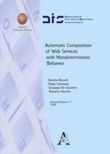
2006/5
Automatic Composition of Web Services with Nondeterministic Behavior
The promise of Web Service Computing is to utilize Web services as fundamental elements for realizing distributed applications/solutions. In particular, when no available service can satisfy client request, (parts of) available services can be composed and orchestrated in order to satisfy such a request. In this paper, we address the automatic composition when the behavior of the available services is nondeterministic, and hence it is not fully controllable by an orchestrator
The promise of Web Service Computing is to utilize Web services as fundamental elements for realizing distributed applications/solutions. In particular, when no available service can satisfy client request, (parts of) available services can be composed and orchestrated in order to satisfy such a request. In this paper, we address the automatic composition when the behavior of the available services is nondeterministic, and hence it is not fully controllable by an orchestrator
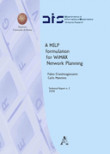
02/08
A MILP formulation for WiMAX Network Planning
We describe a Mixed Integer Linear Programming formulation to optimize base stations location and con¯guration of a wireless network implementing the IEEE standard 802.16 (WiMAX). The system elements relevant to the optimization model are discussed in detail
We describe a Mixed Integer Linear Programming formulation to optimize base stations location and con¯guration of a wireless network implementing the IEEE standard 802.16 (WiMAX). The system elements relevant to the optimization model are discussed in detail
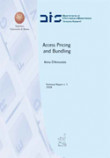
03/2008
Access Pricing and Bundling
A vertically integrated incumbent can engage in anticompetitive behaviours against an entrant in the downstream segment which provides two independent products on the retail market, one that needs the access to the network input and one in monopoly
A vertically integrated incumbent can engage in anticompetitive behaviours against an entrant in the downstream segment which provides two independent products on the retail market, one that needs the access to the network input and one in monopoly

04/2008
Foreign Direct Investment and Environmental Policy
Have Location Factors been Neglected?
This paper analyses the effect of asymmetric environmental policies on the international strategies of firms, when countries differ in terms of market size and barriers to trade and FDI have been removed
Have Location Factors been Neglected?
This paper analyses the effect of asymmetric environmental policies on the international strategies of firms, when countries differ in terms of market size and barriers to trade and FDI have been removed

2007/6
Dynamic Access Pricing and Incentives to Invest in Alternative Infrastructures
We define a dynamic model to assess whether and when the ‘ladder of investment’ regulatory paradigm induces efficient competitive network investment
We define a dynamic model to assess whether and when the ‘ladder of investment’ regulatory paradigm induces efficient competitive network investment
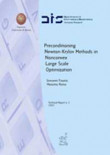
2007/1
Preconditioning Newton-Krylov Methods in Nonconvex Large Scale Optimization
We consider an iterative preconditioning technique for large scale optimization, where the objective function is possibly non-convex.
We consider an iterative preconditioning technique for large scale optimization, where the objective function is possibly non-convex.
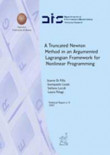
2007/9
A Truncated Newton Method in an Argumented Lagrangian Framework for Nonlinear Programming
In this paper we propose a primal-dual algorithm for the solution of general nonlinear programming problems.
In this paper we propose a primal-dual algorithm for the solution of general nonlinear programming problems.
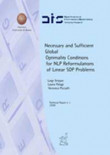
2008/1
Necessary and Sufficient Global Optimality Conditions for NLP Reformulations of Linear SDP Problems
In this paper we consider the standard linear SDP problem, and its low rank nonlinear programming reformulation, based on a Gramian representation of a positive semideï¬nite matrix.
In this paper we consider the standard linear SDP problem, and its low rank nonlinear programming reformulation, based on a Gramian representation of a positive semideï¬nite matrix.
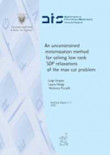
2007/7
An Unconstrained Minimization Method for Solving Low Rank SDP Relaxations of the Max Cut Problem
In this paper we consider low-rank semidefinite programming (LRSDP) relaxations of the max cut problem. Using the Gramian representation of a positive semide¯nite matrix, the LRSDP problem is transformed into the non-convex nonlinear programming problem of minimizing a quadratic functionwith quadratic equality constraints. First, we establish some new relationships among these two formulations and we give necessary and sufficient conditions of [...]
In this paper we consider low-rank semidefinite programming (LRSDP) relaxations of the max cut problem. Using the Gramian representation of a positive semide¯nite matrix, the LRSDP problem is transformed into the non-convex nonlinear programming problem of minimizing a quadratic functionwith quadratic equality constraints. First, we establish some new relationships among these two formulations and we give necessary and sufficient conditions of [...]
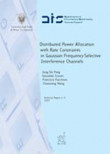
2007/5
Distributed Power Allocation with Rate Constraints in Gaussian Frequency-Selective Interference Channels
This paper considers the minimization of transmit power in Gaussian frequency - selective interference channels, subject to a rate constraint for each user. To derive decentralized solutions that do not require any cooperation among the users, we formulate this power control problem as a (generalized) Nash equilibrium game. We obtain sufficient conditions that guarantee the existence and nonemptiness of the solution set to our problem. Then, to [...]
This paper considers the minimization of transmit power in Gaussian frequency - selective interference channels, subject to a rate constraint for each user. To derive decentralized solutions that do not require any cooperation among the users, we formulate this power control problem as a (generalized) Nash equilibrium game. We obtain sufficient conditions that guarantee the existence and nonemptiness of the solution set to our problem. Then, to [...]
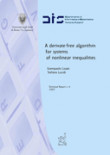
2007/4
A Derivative-Free Algorithm for Systems of Nonlinear Inequalities
Recently a new derivative-free algorithm [6] has been proposed for the solution of linearly constrained finite minimax problems. Such an algorithm can also be used to solve systems of nonlinear inequalities in the case when the derivatives are not available and provided that a suitable reformulation of the system into a minimax problem is carried out. In this paper we show an interesting property of the algorithm proposed in [6] when it is [...]
Recently a new derivative-free algorithm [6] has been proposed for the solution of linearly constrained finite minimax problems. Such an algorithm can also be used to solve systems of nonlinear inequalities in the case when the derivatives are not available and provided that a suitable reformulation of the system into a minimax problem is carried out. In this paper we show an interesting property of the algorithm proposed in [6] when it is [...]
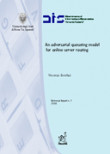
2006/7
An Adversarial Queueing Model for Online Server Routing
We propose a new model for online server routing, based on adversarial queueing theory [3]. The model addresses questions such as whether a server routing algorithm is stable, i.e., it is such that the number of unserved requests in the system remains bounded at any time, or whether the algorithm has bounded flow time, i.e., it is such that every request remains in the system for a bounded amount of time. We consider a number of natural [...]
We propose a new model for online server routing, based on adversarial queueing theory [3]. The model addresses questions such as whether a server routing algorithm is stable, i.e., it is such that the number of unserved requests in the system remains bounded at any time, or whether the algorithm has bounded flow time, i.e., it is such that every request remains in the system for a bounded amount of time. We consider a number of natural [...]
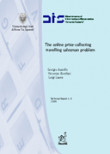
2006/8
The Online Prize-Collecting Traveling Salesman Problem
We study the online version of the Prize-Collecting Traveling Salesman Problem (PCTSP), a generalization of the Traveling Salesman Problem (TSP). In the TSP, the salesman has to visit a set of citieswhile minimizing the length of the overall tour. In the PCTSP, each city has a given weight and penalty, and the goal is to collect a given quota of the weights of the cities while minimizing the length of thetour plus the penalties of the cities not [...]
We study the online version of the Prize-Collecting Traveling Salesman Problem (PCTSP), a generalization of the Traveling Salesman Problem (TSP). In the TSP, the salesman has to visit a set of citieswhile minimizing the length of the overall tour. In the PCTSP, each city has a given weight and penalty, and the goal is to collect a given quota of the weights of the cities while minimizing the length of thetour plus the penalties of the cities not [...]
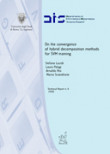
2006/6
On the Convergence of Hybrid Decomposition Methods for SVM Training
Support Vector Machines (SVM) is a widely adopted technique both for classi¯cation and regression problems. Training of SVM requires to solve a linearly constrained convex quadratic problem. In real applications the number of training data may be very huge and the Hessian matrix cannot be stored. In order to take into account this issue a common strategy consists in using decomposition algorithms which at each iteration operate only on a small [...]
Support Vector Machines (SVM) is a widely adopted technique both for classi¯cation and regression problems. Training of SVM requires to solve a linearly constrained convex quadratic problem. In real applications the number of training data may be very huge and the Hessian matrix cannot be stored. In order to take into account this issue a common strategy consists in using decomposition algorithms which at each iteration operate only on a small [...]
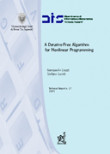
2005/17
A Derative-Free Algorithm for Nonlinear Programming
In this paper the authors consider nonlinear constrained optimization problems in case where the first order derivatives of the objective function and the constraints can not be used.
In this paper the authors consider nonlinear constrained optimization problems in case where the first order derivatives of the objective function and the constraints can not be used.
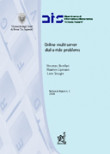
2006/2
Online Multi-Server Dial-A-Ride Problems
In an online dial-a-ride problem, a crew of servers has to process transportation requests as they arrive in real time. Possible objective functions include minimizing the makespan and minimizing the sum of completion times. We give competitive algorithms and negative results for several online dial-a-ride problems with multiple servers. Surprisingly, in some cases the competitive ratio is dramatically better than that of the corresponding single[...]
In an online dial-a-ride problem, a crew of servers has to process transportation requests as they arrive in real time. Possible objective functions include minimizing the makespan and minimizing the sum of completion times. We give competitive algorithms and negative results for several online dial-a-ride problems with multiple servers. Surprisingly, in some cases the competitive ratio is dramatically better than that of the corresponding single[...]
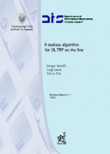
2006/3
A Zealous Algorithm for OL-TRP on the Line
In this paper we present a zealous algorithm for the on-line version of the traveling repairman problem. We analyze this problem in the framework of competitive analysis and we show that this algorithm,called JTAa, is. 6.04-competitive.
In this paper we present a zealous algorithm for the on-line version of the traveling repairman problem. We analyze this problem in the framework of competitive analysis and we show that this algorithm,called JTAa, is. 6.04-competitive.
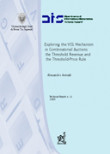
2005/11
Exploring the VCG Mechanism in Combinatorial Auctions
The Threshold Revenue and the Threshold-Price Rule
In this work we explore interesting potentialities of the Vickrey-Clarke-Groves (VCG) mechanism in the auctions context under the assumption of players with independent and private valuations and with no budget constraints. First we apply the VCG rule to a coalition of bidders in order to measure the minimum effort, in terms of submitted bids, that the coalition has to support to win, given the valuations systems of the opponents (i.e. the second[...]
The Threshold Revenue and the Threshold-Price Rule
In this work we explore interesting potentialities of the Vickrey-Clarke-Groves (VCG) mechanism in the auctions context under the assumption of players with independent and private valuations and with no budget constraints. First we apply the VCG rule to a coalition of bidders in order to measure the minimum effort, in terms of submitted bids, that the coalition has to support to win, given the valuations systems of the opponents (i.e. the second[...]

2005/2
On the Power of Lookahead in On-line Vehicle Routing Problems
Vehicle Routing Problems are generalizations of the well known Traveling Salesman Problem; we focus on the on-line version of these problems, where requests are not known in advance and arrive over time. We introduce two models of lookeahead for this class of problems, the time lookahead Δ, which allows an on-line algorithm to foresee all the requests that will be released during next Δ time units, and the request lookahead, which allows an [...]
Vehicle Routing Problems are generalizations of the well known Traveling Salesman Problem; we focus on the on-line version of these problems, where requests are not known in advance and arrive over time. We introduce two models of lookeahead for this class of problems, the time lookahead Δ, which allows an on-line algorithm to foresee all the requests that will be released during next Δ time units, and the request lookahead, which allows an [...]
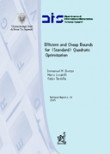
2005/10
Efficient and Cheap Bounds for (Standard) Quadratic Optimization
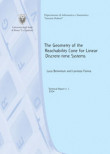
2004/1
The Geometry of the Reachability Cone for Linear Discrete-Time Systems
Technical Reports del Dipartimento di Informatica e Sistemistica “Antonio Ruberti”, Università degli Studi di Roma “La Sapienza”.
Technical Reports del Dipartimento di Informatica e Sistemistica “Antonio Ruberti”, Università degli Studi di Roma “La Sapienza”.
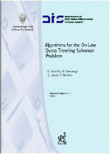
2004/2
Algorithms for the On-Line Quota Traveling Salesman Problem
The Quota Traveling Salesman Problem is a generalization of the well known Traveling Salesman Problem. The goal of the traveling salesman is, in this case, to reach a giiven quota of the sales, minimizing the amount of time, In this paper we address the on-line version od the problem, where requests are given over time. We presents algorithms for various metric spaces, and analyze their performance in the usual framework of the competitive [...]
The Quota Traveling Salesman Problem is a generalization of the well known Traveling Salesman Problem. The goal of the traveling salesman is, in this case, to reach a giiven quota of the sales, minimizing the amount of time, In this paper we address the on-line version od the problem, where requests are given over time. We presents algorithms for various metric spaces, and analyze their performance in the usual framework of the competitive [...]
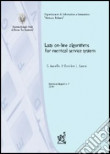
2004/7
Lazy On-Line Algorithms for Metrical Service Systems
In this paper we consider the problem of efficiently serving a sequence of requests in an on-line fashion, where every request is a subset of a metric space and serving a request means moving the unique serve to a point of the subset. Problems of this kind are called metrical service systems (MSS) and are a generalization of problems such as paging, the k.serve problem and the so-called CNN problem.In this context, we give a general definition of[...]
In this paper we consider the problem of efficiently serving a sequence of requests in an on-line fashion, where every request is a subset of a metric space and serving a request means moving the unique serve to a point of the subset. Problems of this kind are called metrical service systems (MSS) and are a generalization of problems such as paging, the k.serve problem and the so-called CNN problem.In this context, we give a general definition of[...]
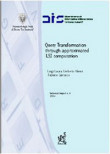
2004/8
Query Transformation through Approximated LSI Computation
The Latent Semantic Indexing (LSI) proved to be an effectife technique in the field of Information Restrieval. Its drawbacks are the time needed to compute the SVD decomposition and to asnwer queries, since the query must be compared against each document in the collection. In this paper we present a techique that uses the information computed by the traditional LSI to provide a fast online answer to the users. Informally, if compared to the [...]
The Latent Semantic Indexing (LSI) proved to be an effectife technique in the field of Information Restrieval. Its drawbacks are the time needed to compute the SVD decomposition and to asnwer queries, since the query must be compared against each document in the collection. In this paper we present a techique that uses the information computed by the traditional LSI to provide a fast online answer to the users. Informally, if compared to the [...]
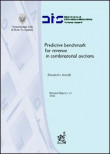
2004/12
Predictive Benchmark for Revenue in Combinatorial Auctions
A goal often desired in auctions is the maximization of the auctioneer’s revenue. Auctions designers need to define some kind of benchmark to measure the effectiveness, in terms of maximizing revenue, of the experimented auction mechanisms. In the case of single-attribute first-price iterative (ascending) combinatorial auctions, with independent and private valuations, we argue that the lower the competition level underlying the players’ [...]
A goal often desired in auctions is the maximization of the auctioneer’s revenue. Auctions designers need to define some kind of benchmark to measure the effectiveness, in terms of maximizing revenue, of the experimented auction mechanisms. In the case of single-attribute first-price iterative (ascending) combinatorial auctions, with independent and private valuations, we argue that the lower the competition level underlying the players’ [...]
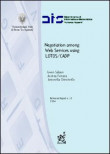
2004/13
Negotiation among Web Services Using Lotos/CADP
It is now well-admitted that formal methods are helpful for many issues raised in the web service area. in a previous work, we advocated the use of process algebra to describe, compose and reson on web services at an abstract level. In this paper, we extend this initial proposal, which only dealt with behavioural aspects, to cope wiche the question of representing data aspects as well. In this context, we show how the expressive process algebra [...]
It is now well-admitted that formal methods are helpful for many issues raised in the web service area. in a previous work, we advocated the use of process algebra to describe, compose and reson on web services at an abstract level. In this paper, we extend this initial proposal, which only dealt with behavioural aspects, to cope wiche the question of representing data aspects as well. In this context, we show how the expressive process algebra [...]
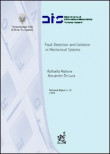
2004/10
Fault Detection and Isolation in Mechanical Systems
Dipartimento di Informatica e Sistemistica “Antonio Ruberti” della “Sapienza” Università di Roma.
Dipartimento di Informatica e Sistemistica “Antonio Ruberti” della “Sapienza” Università di Roma.

2004/17
Web Services
A Process Algebra Approach
It is now well-admitted that formal methods are helpful for many issues raised in the Web service area. In this paper we present a framework for the design and the verification of WSs using process algebras and their tools. We define a two-way mapping between abstract specifications written using these calculi and executable Web services written in BPEL4WS; the translation includes also compensation, event, and fault handlers. The following [...]
A Process Algebra Approach
It is now well-admitted that formal methods are helpful for many issues raised in the Web service area. In this paper we present a framework for the design and the verification of WSs using process algebras and their tools. We define a two-way mapping between abstract specifications written using these calculi and executable Web services written in BPEL4WS; the translation includes also compensation, event, and fault handlers. The following [...]
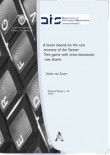
2004/18
A Lower Bound on the Cost Recovery of the Steiner Tree Game with Cross-Monotonic Cost Shares
In this article it is proven that no cross-monotonic cost-sharing method can guarantee a recovery of more than 12 of the cost of the computed tree in the Steiner Tree game. Hence the algorithms described by Jain and Vazirani [3] (Steiner Tree game) and by K¨onemann et al. [2] (Steiner Forest game) are the best possible. This is accomplished by modifying an instance used in the paper by Immorlica et al. [1] for the Facility Location game, and [...]
In this article it is proven that no cross-monotonic cost-sharing method can guarantee a recovery of more than 12 of the cost of the computed tree in the Steiner Tree game. Hence the algorithms described by Jain and Vazirani [3] (Steiner Tree game) and by K¨onemann et al. [2] (Steiner Forest game) are the best possible. This is accomplished by modifying an instance used in the paper by Immorlica et al. [1] for the Facility Location game, and [...]
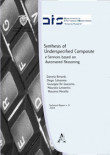
2004/9
Synthesis of Underspecified Composite e-Services Based on Automated Reasoning
In this paper we study automatic composition synthesis of e-Services, based on automated reasoning.
The behavior of an e-Service is represented in terms of a deterministic transition system (or a finite state machine), in which for each action the role of the e-Service, either as initiator or as servant, is highlighted. In this setting we present an algorithm based on a Description Logic that solves the automatic composition problem. [...]
In this paper we study automatic composition synthesis of e-Services, based on automated reasoning.
The behavior of an e-Service is represented in terms of a deterministic transition system (or a finite state machine), in which for each action the role of the e-Service, either as initiator or as servant, is highlighted. In this setting we present an algorithm based on a Description Logic that solves the automatic composition problem. [...]
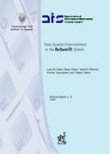
2004/14
Data Quality Improvement in the DaQuinCIS System
Data quality improvement is becoming an increasingly important issue. In contexts where data are replicated among different sources, data quality improvement is possible through extensive data comparisons: whereas copies of same data are different because of data errors, comparisons help to reconcile such copies. Best quality copies can be selected or constructed in order to correct other copies.Record matching algorithms can support the task of [...]
Data quality improvement is becoming an increasingly important issue. In contexts where data are replicated among different sources, data quality improvement is possible through extensive data comparisons: whereas copies of same data are different because of data errors, comparisons help to reconcile such copies. Best quality copies can be selected or constructed in order to correct other copies.Record matching algorithms can support the task of [...]
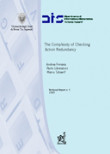
2005/3
The Complexity of Checking Action Redundancy
In the field of reasoning about actions, it is of practical importance to decide whether an action is redundant, i.e. it is not needed to reach the goal. In this paper, we study the computational complexityof several problems related to the redundancy of actions: checking whether a domain contains a redundant action, what is the minimal number of actions needed to make the goal reachable, checkingwhether the removal of an action does not increase[...]
In the field of reasoning about actions, it is of practical importance to decide whether an action is redundant, i.e. it is not needed to reach the goal. In this paper, we study the computational complexityof several problems related to the redundancy of actions: checking whether a domain contains a redundant action, what is the minimal number of actions needed to make the goal reachable, checkingwhether the removal of an action does not increase[...]

2005/6
Automatic Composition of Transition-Based Semantic Web Services with Messaging
In this paper we present Colombo, a framework in which web services are characterized in terms of (i) the atomic processes (i.e., operations) they can perform; (ii) their impact on the “real world” (modeled as a relational database); (iii) their transition-based behavior; and (iv) the messages they can send and receive (from/to other web services and “human” clients). As such, Colombo combines key elements from the standards and research [...]
In this paper we present Colombo, a framework in which web services are characterized in terms of (i) the atomic processes (i.e., operations) they can perform; (ii) their impact on the “real world” (modeled as a relational database); (iii) their transition-based behavior; and (iv) the messages they can send and receive (from/to other web services and “human” clients). As such, Colombo combines key elements from the standards and research [...]

2005/7
Localized Spillovers and Foreign Direct Investment
A Dynamic Analysis
It has been empirically shown that firms invest in foreign countries also with the aim to absorb technological knowledge. However, the recent literature on technological innovation and foreignexpansion has not fully taken into account these features of foreign direct investment. Introducingthis new element into the analysis implies assuming that multinationals and exporters operatewith different degrees of technological spillovers. Our aim is to [...]
A Dynamic Analysis
It has been empirically shown that firms invest in foreign countries also with the aim to absorb technological knowledge. However, the recent literature on technological innovation and foreignexpansion has not fully taken into account these features of foreign direct investment. Introducingthis new element into the analysis implies assuming that multinationals and exporters operatewith different degrees of technological spillovers. Our aim is to [...]
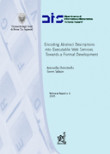
2005/8
Encoding Abstract Descriptions into Executable Web Services
Towards a Formal Development
It is now widely accepted that formal methods are helpful for many issues raised in the web services area. In this report, we advocate the use of process algebra as a first step in the design and development ofexecutable web services. From such formal descriptions, reasoning tools can be used to validate their correct execution.We define some guidelines to encode abstract specifications of services-to-be written using these calculi into [...]
Towards a Formal Development
It is now widely accepted that formal methods are helpful for many issues raised in the web services area. In this report, we advocate the use of process algebra as a first step in the design and development ofexecutable web services. From such formal descriptions, reasoning tools can be used to validate their correct execution.We define some guidelines to encode abstract specifications of services-to-be written using these calculi into [...]
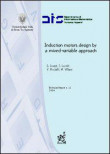
2004/11
Induction Motors Design by a Mixed-Variable Approach
In this paper we consider the optimal design of induction electric motors which can be formulated as a mixed variable programming problem. Two different solution strategies have been used to solve this problem and the obtained results have been analyzed and compared. They are very interesting and show the fruitfulness of directly taking intoaccount the presence of both continuous and discrete variables
In this paper we consider the optimal design of induction electric motors which can be formulated as a mixed variable programming problem. Two different solution strategies have been used to solve this problem and the obtained results have been analyzed and compared. They are very interesting and show the fruitfulness of directly taking intoaccount the presence of both continuous and discrete variables

2005/18
Nonmonotone Globalization of Inexact Finite-Difference Newton-Iterative Methods for Nonlinear Equations
In this paper we study nonmonotone globalization techniques, in connection with finite-difference inexact Newton-GMRES methods, for solving large-scale systems of nonlinear equations in the case that the Jacobian matrix is not available. We first define a globalization scheme, which combines nonmonotone watchdog rules and nonmonotone derivative-free line searches, and we prove its global convergence under the assumptions that the Jacobian is [...]
In this paper we study nonmonotone globalization techniques, in connection with finite-difference inexact Newton-GMRES methods, for solving large-scale systems of nonlinear equations in the case that the Jacobian matrix is not available. We first define a globalization scheme, which combines nonmonotone watchdog rules and nonmonotone derivative-free line searches, and we prove its global convergence under the assumptions that the Jacobian is [...]
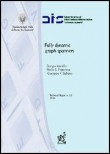
2004/16
Fully Dynamic Graph Spanners
We present fully dynamic algorithms for maintaining 3-spanners of undirected graphs under a sequence of update operations. In the case of graphs with d different edge cost values, we maintain a 3-spanner under insertion and deletion of edges; each operation is performed in O(n) amortized time over a sequence of (d · n) updates. The maintained spanner has O(d · n1.5) edges, which is known to be optimal for constant d. The same approach can be [...]
We present fully dynamic algorithms for maintaining 3-spanners of undirected graphs under a sequence of update operations. In the case of graphs with d different edge cost values, we maintain a 3-spanner under insertion and deletion of edges; each operation is performed in O(n) amortized time over a sequence of (d · n) updates. The maintained spanner has O(d · n1.5) edges, which is known to be optimal for constant d. The same approach can be [...]
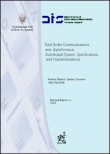
2004/6
Total Order Communications over Asynchronous Distributed Systems
Specifications and Implementations
During the last two decades the design and development of total order (TO) communications has been one of the main research topics in dependable distributed computing. The huge amount of researchwork has produced several TO specifications and a wide variety of TO implementations with different guarantees whose differences are often left hidden or unclear. This paper presents a systematic classification of six distinct TO specifications based on a[...]
Specifications and Implementations
During the last two decades the design and development of total order (TO) communications has been one of the main research topics in dependable distributed computing. The huge amount of researchwork has produced several TO specifications and a wide variety of TO implementations with different guarantees whose differences are often left hidden or unclear. This paper presents a systematic classification of six distinct TO specifications based on a[...]
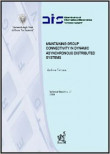
2004/15
Maintaining Group Connectivity in Dynamic Asynchronous Distributed Systems
In the context of asynchronous distributed systems with infinitely many processes, this paper studies the problem of maintaining connectivity among a set of processes forming a group in a dynamic context where (i) processes can arrive to and depart from the group and (ii) processes have a partial knowledge of other processes belonging to thegroup.
In the context of asynchronous distributed systems with infinitely many processes, this paper studies the problem of maintaining connectivity among a set of processes forming a group in a dynamic context where (i) processes can arrive to and depart from the group and (ii) processes have a partial knowledge of other processes belonging to thegroup.
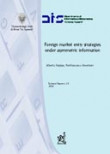
2004/19
Foreign Market Entry Strategies under Asymmetric Information
A home firm signals her private cost information by expanding in a foreign firm’s country. Credible signalling to deter counter-entry may occur through a direct investment (but not through exports) and may even entail entering an unprofitable market. While this produces social benefits, uninformative signalling may be welfare-reducing. Hence, we argue that moderate to high location costs may be sociallydesirable. We also show that there are not[...]
A home firm signals her private cost information by expanding in a foreign firm’s country. Credible signalling to deter counter-entry may occur through a direct investment (but not through exports) and may even entail entering an unprofitable market. While this produces social benefits, uninformative signalling may be welfare-reducing. Hence, we argue that moderate to high location costs may be sociallydesirable. We also show that there are not[...]
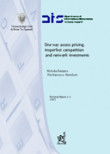
2005/4
One-Way Access Pricing, Imperfect Competition and Network Investments
A facility-based firm invests in network quality and sells local access to her downstream subsidiary and an independent firm, which provide vertically differentiated value-added services. We show that access price regulation is welfare-enhancing, since it fosters competition while preserving investment incentives. This result is robust to four model specifications: i) the regulator credibly commits before the investment stage; ii) there exist [...]
A facility-based firm invests in network quality and sells local access to her downstream subsidiary and an independent firm, which provide vertically differentiated value-added services. We show that access price regulation is welfare-enhancing, since it fosters competition while preserving investment incentives. This result is robust to four model specifications: i) the regulator credibly commits before the investment stage; ii) there exist [...]
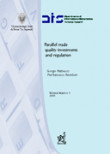
2005/5
Parallel Trade, Quality Investments, and Regulation
A manufacturer investing in product quality sells the good directly in her country, and abroad through an independent firm that practices international arbitrage (Parallel Trade). We show that: i) PT may increase investments if the re-imported product is of lower quality than the domestic product, but reduces investments with perfect substitutes; ii) price regulation (with PT) dilutes this result, since it anyhow raises investments when the [...]
A manufacturer investing in product quality sells the good directly in her country, and abroad through an independent firm that practices international arbitrage (Parallel Trade). We show that: i) PT may increase investments if the re-imported product is of lower quality than the domestic product, but reduces investments with perfect substitutes; ii) price regulation (with PT) dilutes this result, since it anyhow raises investments when the [...]

2005/12
Iterative Computation of Negative Curvative Directions in Large Scale Optimization
Theory and Preliminary Numerical Results
In this paper we deal with the iterative computation of negative curvature directions of an indefinite matrix, within large scale optimization frameworks. In particular, suitable directions of negative curvature of the Hessian matrix represent an essential tool, to guarantee convergence to second order critical points. However, an “adequate” negative curvature direction is often required to have a good resemblanceto an eigenvector [...]
Theory and Preliminary Numerical Results
In this paper we deal with the iterative computation of negative curvature directions of an indefinite matrix, within large scale optimization frameworks. In particular, suitable directions of negative curvature of the Hessian matrix represent an essential tool, to guarantee convergence to second order critical points. However, an “adequate” negative curvature direction is often required to have a good resemblanceto an eigenvector [...]

2005/13
Discrete Level Set Approach to Image Segmentation
Models and algorithms in image processing are usually defined in the continuum and then applied to discrete real data, that is the image data is an array of real values obtained by the signal samples over a lattice. In particular, the set up in the continuum of the segmentation problem allows a fine formulation basically through either a variational or a non linear anisotropic diffusion equation approach. In any case the image segmentation is [...]
Models and algorithms in image processing are usually defined in the continuum and then applied to discrete real data, that is the image data is an array of real values obtained by the signal samples over a lattice. In particular, the set up in the continuum of the segmentation problem allows a fine formulation basically through either a variational or a non linear anisotropic diffusion equation approach. In any case the image segmentation is [...]

2005/9
A Tight 4.67. Approximation Algorithm for the Multi-Commodity Rent-or-Buy Problem
In the multi-commodity rent-or-buy network design problem (MRoB) we are given a network together with a set of k terminal pairs R = {(s1,t1), . . . , (sk,tk)}. The goal is to install capacities on the edges of the network so that a prescribed amount of flow fi can be routed between all terminal pairs si and ti simultaneously. We can either rent capacity on an edge at some cost per unit flow or buy infinite capacity on an edge at some larger fixed[...]
In the multi-commodity rent-or-buy network design problem (MRoB) we are given a network together with a set of k terminal pairs R = {(s1,t1), . . . , (sk,tk)}. The goal is to install capacities on the edges of the network so that a prescribed amount of flow fi can be routed between all terminal pairs si and ti simultaneously. We can either rent capacity on an edge at some cost per unit flow or buy infinite capacity on an edge at some larger fixed[...]
Andreaus Michele, Università di Trento
Angeloni Silvia, Università del Molise
Baldarelli Maria Gabriella, Università di Bologna
Barnabè Federico, Università di Siena
Bernini Francesca, Università di Pisa
Bianchi Carmine, Università di Palermo
Bivona Enzo, Università di Palermo
Cavenago Dario, Università Bicocca – Milano
Chiucchi Maria Serena, Università Politecnica delle Marche
Ciao Biagio, Università Bicocca - Milano
Cincimino Salvatore, Università di Palermo
Corbella Silvano, Università di Verona
Costa Massimo, Università di Palermo
Della Corte Valentina, Università di Napoli – Federico II
Depperu Donatella, Università Cattolica del Sacro Cuore - Milano
Fortuna Fabio, Università Telematica N.Cusano di Roma
Garibaldi Roberta, Università di Bergamo
Gonnella Enrico, Università di Pisa
Invernizzi Giorgio, Università L. Bocconi - Milano
Liberatore Giovanni, Università di Firenze
Mari Libero Mario, Università di Perugia
Miraglia Rosalba, Università di Catania
Pastore Patrizia, Università della Calabria
Pencarelli Tonino, Università di Urbino
Pulejo Luisa, Università di Messina
Ricciardi Antonio, Università della Calabria
Ruggiero Pasquale, Università di Siena – University of Brighton
Rusconi Gianfranco, Università di Bergamo
Signori Silvana, Università di Bergamo
Silvia Tommaso, Università della Calabria
Sorci Carlo, Università di Palermo
Zattoni Alessandro, Università Uniparthenope – Napoli
Angeloni Silvia, Università del Molise
Baldarelli Maria Gabriella, Università di Bologna
Barnabè Federico, Università di Siena
Bernini Francesca, Università di Pisa
Bianchi Carmine, Università di Palermo
Bivona Enzo, Università di Palermo
Cavenago Dario, Università Bicocca – Milano
Chiucchi Maria Serena, Università Politecnica delle Marche
Ciao Biagio, Università Bicocca - Milano
Cincimino Salvatore, Università di Palermo
Corbella Silvano, Università di Verona
Costa Massimo, Università di Palermo
Della Corte Valentina, Università di Napoli – Federico II
Depperu Donatella, Università Cattolica del Sacro Cuore - Milano
Fortuna Fabio, Università Telematica N.Cusano di Roma
Garibaldi Roberta, Università di Bergamo
Gonnella Enrico, Università di Pisa
Invernizzi Giorgio, Università L. Bocconi - Milano
Liberatore Giovanni, Università di Firenze
Mari Libero Mario, Università di Perugia
Miraglia Rosalba, Università di Catania
Pastore Patrizia, Università della Calabria
Pencarelli Tonino, Università di Urbino
Pulejo Luisa, Università di Messina
Ricciardi Antonio, Università della Calabria
Ruggiero Pasquale, Università di Siena – University of Brighton
Rusconi Gianfranco, Università di Bergamo
Signori Silvana, Università di Bergamo
Silvia Tommaso, Università della Calabria
Sorci Carlo, Università di Palermo
Zattoni Alessandro, Università Uniparthenope – Napoli
Processo di presentazione, valutazione ed accettazione dei contributi in volume (opere monografiche, raccolte e atti di convegno)
Il processo che porta alla pubblicazione di un prodotto monografico prende avvio con la proposta avanzata dall’Autore (progetto editoriale o lavoro monografico già definito). Tale proposta, corredata dal curriculum vitae dell’autore, va inviata al coordinatore scientifico della collana (Marcantonio Ruisi: marcantonio.ruisi@unipa.it). Il suo contenuto verrà preferibilmente esplicitato in una scheda di sintesi che dovrà coprire i seguenti punti: titolo (seppur non definitivo) dell’opera monografica, tematica generale di riferimento, obiettivi conoscitivi, metodo di ricerca, stato dell’arte della conoscenza scientifica, contributo all’avanzamento delle conoscenza, eventuali implicazioni per lo sviluppo aziendale e sociale, eventuale indice del volume. La proposta viene preliminarmente esaminata dal coordinatore che, nel caso di valutazione positiva e dopo aver espresso il proprio parere in forma scritta, sottopone, avendo cura di renderla anonima, la proposta stessa a tutto o parte (almeno tre componenti) del comitato scientifico. Il comitato scientifico avrà il compito di confermare l’accettazione della proposta verificando, in particolare, la corrispondenza con l’oggetto della collana, l’originalità del progetto e il contributo conoscitivo che intende apportare nell’ambito della letteratura economico-aziendale in generale e di quella specialistica riguardante il particolare tema trattato. L’accettazione della proposta avverrà a maggioranza assoluta dei componenti del comitato scientifico o di quelli coinvolti e avverrà in forma scritta. Nel documento di accettazione potranno essere riportati anche commenti, indicazioni, suggerimenti da far pervenire all’autore per migliorare il proprio progetto di editoriale o la monografia se sussistente. Di norma, la trasmissione della proposta avviene in formato elettronico via mail. Ogni componente coinvolto del comitato scientifico ha un tempo perentorio di due settimane per esprimere un parere sulla proposta progettuale o sul lavoro monografico o collettaneo presentato. Nel caso in cui il parere non arrivi entro i tempi previsti si considera il principio del silenzio assenso.
Il coordinatore acquisito il parere positivo dei componenti coinvolti del comitato scientifico, trasmette, nel caso di proposta progettuale, la decisione all’autore/curatore inviandogli anche eventuali commenti e suggerimenti esplicitati; nel caso di volume già definito, avvia direttamente il lavoro di referaggio secondo le modalità di seguito esplicitate. Contestualmente alla trasmissione del parere positivo, viene comunicata all’autore/curatore che ha presentato la mera proposta progettuale, la scadenza inerente la presentazione dell’opera completa, che di norma non può essere superiore ad un anno.
L’attività di referaggio avviene secondo le modalità del processo Double Blind Review (doppio referaggio anonimo). Il coordinatore, dunque, nominerà tra i membri del comitato scientifico un responsabile del processo di revisione e due revisori all’interno dell’elenco dei reviewer della collana. Il responsabile del processo è incaricato di ricevere il lavoro e di trasmetterlo ai due revisori prescelti. Il processo di referaggio si basa sull’assoluto rapporto di anonimato tra autore e revisori e si conclude entro due mesi dalla presentazione del volume. In caso di lavoro collettaneo o di atti di convegno, la proposta editoriale dovrà essere presentata dal curatore del volume (che dovrà presentare altresì il curriculum di ogni autore presente nel collettaneo) e ogni singolo contributo sarà sottoposto a referaggio (in tal caso i revisori potrebbero anche essere più di due). I revisori sono proposti dal coordinatore e dagli altri membri del comitato scientifico tra i professori ordinari e associati e tra i ricercatori (a tempo indeterminato e determinato) delle discipline economico aziendali appartenenti all’ordinamento accademico italiano e da ora internazionali aventi ruoli equipollenti rispetto agli studiosi nazionali. Nell’elenco dei revisori (suscettibile di aggiornamento) sono compresi i membri del comitato scientifico e del comitato di redazione, mentre né è escluso il coordinatore. Nel caso di proposta di monografia da parte di un membro del comitato scientifico, esso sarò escluso dall’intero processo di valutazione a partire dall’accettazione della stessa proposta.
Il revisore dovrà compilare una relazione analitica in cui spiegherà le motivazioni alla base della propria scelta. Ogni revisore terminerà la propria relazione con uno dei seguenti pareri di sintesi: lavoro pubblicabile, lavoro pubblicabile con minime revisioni, lavoro pubblicabile con revisioni sostanziali, lavoro non pubblicabile. Nel caso di lavoro pubblicabile con minime revisioni, l’autore avrà un mese per apportare le modifiche richieste o per accogliere eventuali suggerimenti, nel caso di lavoro pubblicabile con revisioni sostanziali l’autore avrà, invece, a disposizione due mesi per riconsegnare il lavoro. Per l’eventuale secondo momento di referaggio, il tempo richiesto ai revisori per esprimere il loro parere sarà celere e l’esisto finale sarà un giudizio sulla pubblicabilità o meno dell’elaborato. Qualora i due revisori avessero pareri totalmente discordi ed inconciliabili, il responsabile del referaggio può in alternativa, avocare a sé la decisione circa la pubblicabilità del lavoro, nominare un terzo revisore, rinviare la decisione al coordinatore.
Il processo che porta alla pubblicazione di un prodotto monografico prende avvio con la proposta avanzata dall’Autore (progetto editoriale o lavoro monografico già definito). Tale proposta, corredata dal curriculum vitae dell’autore, va inviata al coordinatore scientifico della collana (Marcantonio Ruisi: marcantonio.ruisi@unipa.it). Il suo contenuto verrà preferibilmente esplicitato in una scheda di sintesi che dovrà coprire i seguenti punti: titolo (seppur non definitivo) dell’opera monografica, tematica generale di riferimento, obiettivi conoscitivi, metodo di ricerca, stato dell’arte della conoscenza scientifica, contributo all’avanzamento delle conoscenza, eventuali implicazioni per lo sviluppo aziendale e sociale, eventuale indice del volume. La proposta viene preliminarmente esaminata dal coordinatore che, nel caso di valutazione positiva e dopo aver espresso il proprio parere in forma scritta, sottopone, avendo cura di renderla anonima, la proposta stessa a tutto o parte (almeno tre componenti) del comitato scientifico. Il comitato scientifico avrà il compito di confermare l’accettazione della proposta verificando, in particolare, la corrispondenza con l’oggetto della collana, l’originalità del progetto e il contributo conoscitivo che intende apportare nell’ambito della letteratura economico-aziendale in generale e di quella specialistica riguardante il particolare tema trattato. L’accettazione della proposta avverrà a maggioranza assoluta dei componenti del comitato scientifico o di quelli coinvolti e avverrà in forma scritta. Nel documento di accettazione potranno essere riportati anche commenti, indicazioni, suggerimenti da far pervenire all’autore per migliorare il proprio progetto di editoriale o la monografia se sussistente. Di norma, la trasmissione della proposta avviene in formato elettronico via mail. Ogni componente coinvolto del comitato scientifico ha un tempo perentorio di due settimane per esprimere un parere sulla proposta progettuale o sul lavoro monografico o collettaneo presentato. Nel caso in cui il parere non arrivi entro i tempi previsti si considera il principio del silenzio assenso.
Il coordinatore acquisito il parere positivo dei componenti coinvolti del comitato scientifico, trasmette, nel caso di proposta progettuale, la decisione all’autore/curatore inviandogli anche eventuali commenti e suggerimenti esplicitati; nel caso di volume già definito, avvia direttamente il lavoro di referaggio secondo le modalità di seguito esplicitate. Contestualmente alla trasmissione del parere positivo, viene comunicata all’autore/curatore che ha presentato la mera proposta progettuale, la scadenza inerente la presentazione dell’opera completa, che di norma non può essere superiore ad un anno.
L’attività di referaggio avviene secondo le modalità del processo Double Blind Review (doppio referaggio anonimo). Il coordinatore, dunque, nominerà tra i membri del comitato scientifico un responsabile del processo di revisione e due revisori all’interno dell’elenco dei reviewer della collana. Il responsabile del processo è incaricato di ricevere il lavoro e di trasmetterlo ai due revisori prescelti. Il processo di referaggio si basa sull’assoluto rapporto di anonimato tra autore e revisori e si conclude entro due mesi dalla presentazione del volume. In caso di lavoro collettaneo o di atti di convegno, la proposta editoriale dovrà essere presentata dal curatore del volume (che dovrà presentare altresì il curriculum di ogni autore presente nel collettaneo) e ogni singolo contributo sarà sottoposto a referaggio (in tal caso i revisori potrebbero anche essere più di due). I revisori sono proposti dal coordinatore e dagli altri membri del comitato scientifico tra i professori ordinari e associati e tra i ricercatori (a tempo indeterminato e determinato) delle discipline economico aziendali appartenenti all’ordinamento accademico italiano e da ora internazionali aventi ruoli equipollenti rispetto agli studiosi nazionali. Nell’elenco dei revisori (suscettibile di aggiornamento) sono compresi i membri del comitato scientifico e del comitato di redazione, mentre né è escluso il coordinatore. Nel caso di proposta di monografia da parte di un membro del comitato scientifico, esso sarò escluso dall’intero processo di valutazione a partire dall’accettazione della stessa proposta.
Il revisore dovrà compilare una relazione analitica in cui spiegherà le motivazioni alla base della propria scelta. Ogni revisore terminerà la propria relazione con uno dei seguenti pareri di sintesi: lavoro pubblicabile, lavoro pubblicabile con minime revisioni, lavoro pubblicabile con revisioni sostanziali, lavoro non pubblicabile. Nel caso di lavoro pubblicabile con minime revisioni, l’autore avrà un mese per apportare le modifiche richieste o per accogliere eventuali suggerimenti, nel caso di lavoro pubblicabile con revisioni sostanziali l’autore avrà, invece, a disposizione due mesi per riconsegnare il lavoro. Per l’eventuale secondo momento di referaggio, il tempo richiesto ai revisori per esprimere il loro parere sarà celere e l’esisto finale sarà un giudizio sulla pubblicabilità o meno dell’elaborato. Qualora i due revisori avessero pareri totalmente discordi ed inconciliabili, il responsabile del referaggio può in alternativa, avocare a sé la decisione circa la pubblicabilità del lavoro, nominare un terzo revisore, rinviare la decisione al coordinatore.
EVENTI
VIDEO
recensioni
approfondimenti

SINTESI
PUBBLICAZIONI
COLLANE COLLEGATE

Informativa
Aracneeditrice.it si avvale di cookie, anche di terze parti, per offrirti il migliore servizio possibile. Cliccando 'Accetto' o continuando la navigazione ne acconsenti l'utilizzo. Per saperne di più
Accetto









